Some thoughts on the AR-15/M-16
All photos in this page are taken from the web.

| Model | Length Overall | Barrel | Weight (unloaded) | Caliber | Action Type | Magazine Capacity |
| M-16A1 | 39" | 20" 1 in 12" twist | 6.3 pounds | .223 | gas operated select | 30 |
| M-16A2 | 39.63" | 20" 1 in 7" twist | 8.79 pounds | .223 | gas operated select | 30 |
| M-16A3 | 39.37" | 20" 1 in 7" twist | 8.3 pounds | .223 | gas operated burst | 30 |
A replacement was being sought for the trusty Garrand rifle, with which the U.S. had won the Second World War. A requirement was set forth, that these new rifles needed to fire, the new 7.62x51 round, a shortened version of the classic 30-06 cartridge. Eugene Stoner, and his team at Armalite, incorporated new design and manufacturing concepts, many taken from Stoner's experience in the aircraft industry, and came up with what they called the AR-10 rifle, in the required 7.62 chambering. The design concept, ergonomics, and operation of the AR-10, were identical to those of the latter M-16. The trials were won by the excellent, but more traditional M-14, a descendant of the Garrand.
The failure of the trials, sent Stoner, and his team back to the drawing boards. Though their rifle had not secured a government contract, loss of the trials had freed Armalite from the need to keep their design within Bureau of Ordnance design parameters. After some real world tests the team decided to lighten and shorten the piece, and design a new intermediate sized cartridge for it. The studies which brought about these changes concluded that most encounters took place at rather close range (mostly within 100 yards, and rarely outside of 300 yards) where the power of a full sized cartridge was wasted. It was also thought that the armies of the future would be larger and less skilled, and that a lighter rifle with milder recoil would lessen training time. The final factor was that an infantryman could carry twice as much of the new 223 ammunition as compared with the standard 308 cartridge. The rifle and the ammunition were designed to work together. The rifle used a rather slow 1 in 14" twist to stabilize the new ammunition. The ammunition itself used a new type of extruded powder which was slower burning than the traditional military ball powders. The long, thin bullet was only marginally stable when it left the barrel of the gun, and when it hit it's target, it immediately began to tumble and spin, with devastating results.
The new rifles were snubbed by the Army, which wanted nothing to do with a new cartridge, or with a rifle design, which their tests had previously failed. There was also a certain resistance to a rifle which was not designed "in house". Fortunately for Armalite, Curtis LeMay, head of the Air Force, had got wind of the new design, and was interested. He considered the idea of a light, full auto arm, to be ideal for base security forces, at that time using old M-3 Grease Guns, or M-1 carbines. Regarding the non-traditional design, the Air Force had always considered itself to be a non-traditional, cutting edge service. The rifle was demonstrated to LeMay at a practice range, using watermelons as targets, The general was then invited to fire the rifle himself, to experience the ease of use, and low recoil during full auto fire. The general was suitably impressed, and witnesses claim that he gave a good accounting of himself, hitting the watermelons with ease. Some of the rifles found their way into special forces units, during the early stages of the Viet Nam war. The early users were very enthusiastic about the performance of their new guns, and were particularly impressed by the massive wounds made by the small caliber projectiles. These reports eventually drifted up to the heads of the military, and to the Department of Defense. The rifle could no longer be ignored, and a new set of trials were arranged. The Bureau of Ordnance rigged the tests, in an attempt to discredit the rifle. Having gotten wind of these machinations, the Kennedy administration, and the Department of Defense ordered the Army to adopt the new design, now being made by Colt. A Presidential order, gave the Army no choice; they accepted the new M-16 rifle into service in 1963.
The Bureau of Ordnance saw to it that they had the last laugh, however, even if this was to be at the expense of the soldiers they were charged with finding the best armament for. Unfortunately, the Bureau of Ordnance saw to it that the ammunition and then the rifle were modified shortly after entering service. The ammunition was loaded
 using standard ball powders which are faster burning, and much dirtier
than extruded powders. This very nearly doubled the cyclic rate, making
the gun unreliable, and almost uncontrollable in full auto fire. The dirty
burning powder was not a problem on a standard rifle with a large piston
directly under the gas port, but in the M-16, it clogged the slim gas tube
which impinged on the bolt carrier. The military never admitted it's mistake,
and the reliability problems were solved by making alterations in the rifle.
Unfortunately the Military also decided to adopt a faster rifling twist
of 1 in 12" and then 1 in 7" to better stabilize the bullet. This greatly
reduced the killing power of the rifle although it did slightly improve scores
in military matches.
using standard ball powders which are faster burning, and much dirtier
than extruded powders. This very nearly doubled the cyclic rate, making
the gun unreliable, and almost uncontrollable in full auto fire. The dirty
burning powder was not a problem on a standard rifle with a large piston
directly under the gas port, but in the M-16, it clogged the slim gas tube
which impinged on the bolt carrier. The military never admitted it's mistake,
and the reliability problems were solved by making alterations in the rifle.
Unfortunately the Military also decided to adopt a faster rifling twist
of 1 in 12" and then 1 in 7" to better stabilize the bullet. This greatly
reduced the killing power of the rifle although it did slightly improve scores
in military matches. The civilian legal AR-15, has become a popular sporting arm, and has generated quite a following among survivalists, and military collectors. The gun has been thoroughly field tested, and the bugs have pretty much been worked out. Though I consider the HK91 to be a superior .223 rifle, the AR-15 is far better than the Mini-14, or any of the other "civilian" semi autos on the market. The AR-15 also has the advantages of relatively low cost (for this type of weapon), high availability (for those not trapped in california, new jersey, or new york), and high availability of parts, and gear. This weapon was invented by Armalite, and largely manufactured by Colt, for the military. Colt introduced a civilian, semi auto version, shortly after the rifle was accepted for service, but never seemed really comfortable with selling it. Today, the company seems down right ashamed of the gun, and even stopped selling it outside of police circles, for a short time. A look in the current Colt catalog will turn up no mention of the civilian AR-15. Instead, you will find a listing for the Colt Accurized Rifle, or the Colt Match Target Rifle. There are, of course, no flash hiders, or bayonet lugs on these rifles. There are also no shortened rifles, or collapsible stocks available. Civilians can not be trusted with such anti social things, and it has been determined by our moral betters, that we have no proven need for them, in any event. Actual AR-15 rifles, with bayonet lugs, flash hiders, and everything else, are available from Colt's law enforcement division, to "qualified buyers" only. The Colt rifles, even the law enforcement versions, do not take standard mil spec parts.
Presently, the only way for a civilian to get mil spec parts, is through DPMS, Bushmaster, Olympic arms, or another third party company. These companies offer standard parts, with a universal fit, and even offer fully assembled rifles, or rifle kits, which they are not ashamed to call AR-15's. Olympic arms started out as SGW, and has recently acquired Safari arms, and offers a line of 1911 style pistols. I have never had a real high opinion of Safari Arms pistols, but have always held Olympic in the highest regard. I hope that some of the quality of the old SGW gun works rubs off on the Safari Arms line. DPMS is a contract company, which distributes mil spec parts for the AR-15, and M1911. DPMS is more a parts vendor than a gun maker. They offer a large assortment of receivers, parts kits, and dress up gear for the AR-15.
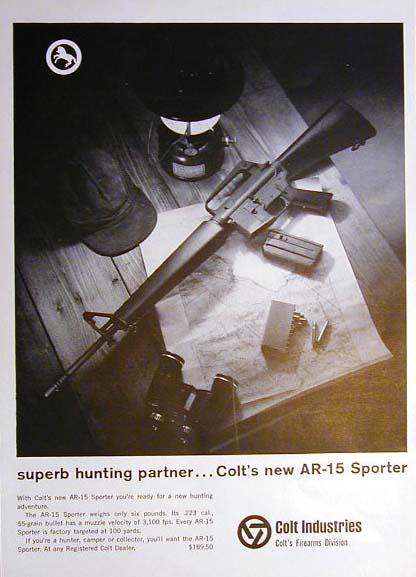 taken a keen interest in military arms, since the end of the Second World
War, and Colt perceived a market. This was, in part, a result of the glut
of surplus weapons coming out of the war. Traditionally, hunters,
sportsman, and citizens looking for a dependable means of defense, had come
to appreciate the proven designs adopted by the military. In many cases,
these were men who had served in the armed forces, and thus been familiarized
with the nation's service weapons. Often, military weapons can be picked
up at a reasonable cost, particularly for systems which are being retired.
Ammunition is readily available, as are parts, and a large base of knowledge
is available from service armourers. On top of everything else, the military
has done all of the development work, ironed out the bugs, and proved the
design, under the most unfavorable conditions.
taken a keen interest in military arms, since the end of the Second World
War, and Colt perceived a market. This was, in part, a result of the glut
of surplus weapons coming out of the war. Traditionally, hunters,
sportsman, and citizens looking for a dependable means of defense, had come
to appreciate the proven designs adopted by the military. In many cases,
these were men who had served in the armed forces, and thus been familiarized
with the nation's service weapons. Often, military weapons can be picked
up at a reasonable cost, particularly for systems which are being retired.
Ammunition is readily available, as are parts, and a large base of knowledge
is available from service armourers. On top of everything else, the military
has done all of the development work, ironed out the bugs, and proved the
design, under the most unfavorable conditions. Armalite had sold production rights to Colt, back in 1959. The weapon was adapted by the Air Force in 1960, and by the Army in 1963. In the early sixties, the Colt factory was already tooled up for military production of the rifle, so it would seem to be a simple matter to make a civilian run. Though past military rifles had routinely found their way into the hands of civilian shooters, the M-16 was different. Unlike the old Garrand, and Springfield rifles, or the M1A version of the M-14, the M-16 is fully automatic. Full auto arms are rather highly restricted, and require time, money, and paperwork to buy. Though fully auto M-16 rifles have been sold to civilians, the market is a very small one, and it was hoped that a much wider market could be exploited by the design of a semi auto rifle. Colt is a private venture, which markets it's products to the public, unlike the Army Ordnance Bureau, which had developed past military rifles. In 1964, Colt introduced a semi auto only version of the M-16, for civilian sales. The advertisement, shown to the right, is the initial announcement of the rifle, and was taken from an old magazine. Note the price (circa 1964) of $189.50.
Before adoption of the M-16, the Army made certain changes to the design, including a forward assist unit, and a change in
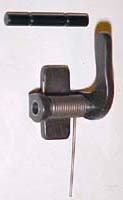 barrel twist. These changes, which reduced the effectiveness of the M-16,
were not incorporated into the civilian model, though other changes would
have to be made, in order to keep the "sporting" versions of these guns
within the law. There were some slight problems facing the Colt engineers,
in converting a rifle designed for select fire, to a semi auto only model.
Though changes needed to be made, it turned out that the basic trigger mechanism
could be retained. The parts needed only modification, not replacement.
The table below, shows a comparison of the bolts, and the trigger groups,
from the M-16, and the AR-15 rifles. The photo to the left, is a close up
of the auto sear. The auto sear was, of course, removed, as it has no function,
during semi auto fire. A forward section of the disconnector was cut off,
and one of the lobes of the selector switch was reshaped. Either one of these
changes would have made the new AR-15 capable of semi auto fire only, but
for good measure, Colt also milled away the hook on the top of the hammer,
and milled out a part of the bottom of the bolt carrier, shortening the
section which ordinarily trips the auto sear. The AR-15 lower receiver,
though made from the same casting as the M-16 version, differs in a couple
of respects. The AR-15 lower is missing the hole for the auto sear pivot
pin, and the rear portion is not milled out to the same width as that of
the M-16. Because of this, the standard trigger will not fit (it's pivot
pin molding sticks out more), and the auto sear can not be installed. These
modifications were all made in accordance with the BATF mandate, requiring
that civilian firearms not be readily convertible to full auto fire.
barrel twist. These changes, which reduced the effectiveness of the M-16,
were not incorporated into the civilian model, though other changes would
have to be made, in order to keep the "sporting" versions of these guns
within the law. There were some slight problems facing the Colt engineers,
in converting a rifle designed for select fire, to a semi auto only model.
Though changes needed to be made, it turned out that the basic trigger mechanism
could be retained. The parts needed only modification, not replacement.
The table below, shows a comparison of the bolts, and the trigger groups,
from the M-16, and the AR-15 rifles. The photo to the left, is a close up
of the auto sear. The auto sear was, of course, removed, as it has no function,
during semi auto fire. A forward section of the disconnector was cut off,
and one of the lobes of the selector switch was reshaped. Either one of these
changes would have made the new AR-15 capable of semi auto fire only, but
for good measure, Colt also milled away the hook on the top of the hammer,
and milled out a part of the bottom of the bolt carrier, shortening the
section which ordinarily trips the auto sear. The AR-15 lower receiver,
though made from the same casting as the M-16 version, differs in a couple
of respects. The AR-15 lower is missing the hole for the auto sear pivot
pin, and the rear portion is not milled out to the same width as that of
the M-16. Because of this, the standard trigger will not fit (it's pivot
pin molding sticks out more), and the auto sear can not be installed. These
modifications were all made in accordance with the BATF mandate, requiring
that civilian firearms not be readily convertible to full auto fire.

|
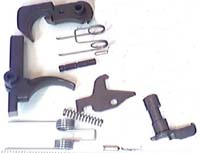
AR-15 Trigger group Hook milled from hammer, no extension on disconnector, and less radical arc on selector switch. Internal portion of trigger is narrower |

Top=AR-15 bolt carrier; Bottom=M-16 carrier Note the rear of the carrier (left side of photos) where the AR-15 unit has been milled further back, than the M-16 version. |
|
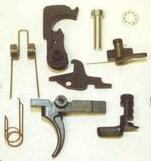 M-16 Standard Full Auto Trigger group
M-16 Standard Full Auto Trigger group Note the hook on the upper portion of the hammer, also the extension on the back of the disconnector. |
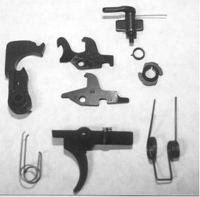 M-16 Tri-Burst Trigger Group
M-16 Tri-Burst Trigger Group The Trigger group of the M-16A2, is nearly identical to the standard group, except for the special disconnector, and the ratchet set on the auto sear. Along with many other changes, that A2 version of the M-16 features three round burst capacity, but no full auto fire. |
Current Models
 During four decades of production, of military and civilian
rifles, a number of variants have been built upon the basic M-16/AR-15
design. The earliest changes were those imposed upon Colt by the Army.
This was the addition of the forward assist unit, the change in rifling,
and the chrome plating of the chamber. Other early variations included the
shortened version often known as the CAR-15, or commando model. There were
also heavy barreled and belt fed versions designed to be used as squad level
weapons. Most of these variants were unissued, or were issued only in very
small numbers. There have been two major model variants of the issue rifle.
During four decades of production, of military and civilian
rifles, a number of variants have been built upon the basic M-16/AR-15
design. The earliest changes were those imposed upon Colt by the Army.
This was the addition of the forward assist unit, the change in rifling,
and the chrome plating of the chamber. Other early variations included the
shortened version often known as the CAR-15, or commando model. There were
also heavy barreled and belt fed versions designed to be used as squad level
weapons. Most of these variants were unissued, or were issued only in very
small numbers. There have been two major model variants of the issue rifle.
In 1981, it had been decided that the M-16 was lacking in long range power, when compared to the 7.62 NATO round, and some others. This should come as no surprise considering that the .223 round was designed to be effective, out between 100 and 300 yards. These ranges were chosen as a result of research which determined that these were the typical ranges at which firefights took place. There was a desire to increase the power and range of this cartridge, to the point where it would be a bit more comparable to those of the NATO round. Such a change would be contrary to the original design and concept of the .223 round, as developed by Armalite. It seems as if the ghosts of the old Bureau of Ordnance had returned to haunt the M-16 once more, or perhaps the lessons learn by a previous generation had been forgotten in the twenty years since the rifle had entered service.
 The design update included a new, much faster, rifling
twist, which would be required to stabilize the new, heavier bullet.
It also included a considerably strengthened stock, heavier barrel, redesigned
grip, rounded hanguards (replacing the odd triangular version on the A1),
and a three shot burst capacity. It also featured a fully adjustable rear
sight, rather than the windage only version on the A1. The latter A3, and
A4 designs featured a new modular receiver configuration, which offered
a number of different sighting options, along with the option of doing away
with the carrying handle. The A3 is fully automatic, after the fashion
of the A1. The A4 has the three shot burst feature of the A2.
The design update included a new, much faster, rifling
twist, which would be required to stabilize the new, heavier bullet.
It also included a considerably strengthened stock, heavier barrel, redesigned
grip, rounded hanguards (replacing the odd triangular version on the A1),
and a three shot burst capacity. It also featured a fully adjustable rear
sight, rather than the windage only version on the A1. The latter A3, and
A4 designs featured a new modular receiver configuration, which offered
a number of different sighting options, along with the option of doing away
with the carrying handle. The A3 is fully automatic, after the fashion
of the A1. The A4 has the three shot burst feature of the A2.
There are a number of sources, presently, for AR-15 parts, completed rifles, and upper conversion kits. Interestingly, all of these clone rifles are made to mil spec, and all will interchange with those of other mil spec manufacturers. The single exception to this is, ironically, Colt, which went out of it's way to make AR-15 parts, as incompatible with mil spec parts as was practical. Some of the clone manufactures are linked to at the bottom of this page. Most of these companies had formerly been subcontractors to Colt, or to the military for parts.
One interesting option offered, particularly by Olympic arms, is the purchase of semi complete rifle kits. These tend to be far less expensive than the purchase of fully assembled rifles. The idea here, is that rifles are sold complete, except for the lower receiver. As far as the BATF is concerned, the lower receiver is the actual firearm, the other components are simply parts. They may thus, be ordered easily, through the net, mail order, or by phone. It is a simple enough matter to then buy a lower receiver at a local show, and have it legally transferred. A complete rifle would then be assembled, at far less cost, than the regular purchase price. There are no laws in this country against owner built firearms, as long as the weapon itself is legal to own, and any paperwork or qualifications required in the builder's local jurisdiction are satisfied. The only trouble spot here, is that the rifle could not be sold, unless the owner paid a VAT on it.
Many of the clone manufacturers also offer upper conversion kits. This is a simple concept, but is something which Colt never really saw fit to do. The idea behind this is that the upper, and lower receivers, of an M-16/AR-15, are completely separate functional units. The basic rifle has been made available in a number of different barrel lengths, and calibers, which are essentially the same lower receiver unit, mated with different upper receiver units. It should be a simple enough matter, then, to change calibers, and barrel lengths, by removing the two pins holding the upper, and lower units together, and replacing the upper. There are several advantages to this, particularly in the odd legal structure which is built around firearms ownership.
With the law making assault rifle ownership increasingly difficult and expensive, particularly for the so called pre-ban units, having a variety of rifles in different calibers, and configurations, is getting to be a pretty daunting task. With a selection of uppers, one can have a unit which is, on paper, a single assault rifle, but can functionally be made to fill the roles of a variety of different weapons, by simply swapping out upper units. Colt has never offered this sort of flexibility, but it is widely available from the clone manufacturers. Unlike the purchase of a complete rifle, these conversion units may be purchased through the mail, and no paperwork is required. The only trap for the unwary, is the danger of affixing a pre ban style upper (with bayonet lug, and flash hide) onto a post ban lower. Doing such a thing would constitute a felony.
As with any military firearm, parts , and accessories are plentiful, cheap, and varied. There is a wide selection of military web gear, and surplus magazines are now reasonably priced, since much of the gun ban hysteria has faded. The popularity of the system with police teams, means that there is also much police, and commercial gear available, for those who do not care for military gear. There have also come to be a dazzling array of sighting, and mounting systems, along with product improvement packages from companies like Rhino. It is unlikely that the AR-15 owner will ever be lacking in parts, gear, or
 options for this rifle.
options for this rifle. The AR-15 has the distinction of being banned, not only by feature, but by name. It was one of only nineteen weapons to have earned this distinction. The effect this has had on the market, was the inspiration of a number of models, by an assortment of manufacturers, which are said to be "based" upon the AR-15. What these rifles have in common, is the lack of a flash hide, and bayonet lug. In some cases, odd, thumbhole stocks have been added. These "new" rifles have then been renamed, and thus can be legally sold to the public. This is rather like the GM/Ford practice of taking the same automobile, renaming it, making some cosmetic changes, and then selling it under the pretense of being several different models. Thus, the Camaro becomes the Firebird, The Taurus becomes the Sable, and the AR-15 becomes the Colt Sporting Rifle, or the Olympic Arms Military Match Rifle.
My present collection of AR-15 rifles are all manufactured by Olympic Arms. I had owned a Colt AR-15 (an sp1 model) some years back, but was not particularly impressed by it. These are all pre-ban rifles, except for a pistol version ,which was not in production until after the ban was in place. The Olympics are easily the equal of the Colts in quality, seem to be tighter (my old Colt rattled a bit; my Olympics do not), and have a smooth black finish, which I prefer to the dull gray of the Colt. The Olympic Arms people are very serious about the quality of their weapons, and are actively involved in extending the capability of this design. The Ultra Match is probably the most accurate AR-15 made, and may be one of the most accurate of any semi auto firearm. Even their standard models have creditable accuracy.
DPMS, and Bushmaster also offer arms of good quality, though Bushmaster has been hurt lately by some very poor quality weapons assembled from their parts kits. I have heard some mixed things about the Bushmaster guns. Their better efforts are of good quality, though I do not consider them to be the equal of the Olympic arms product. DPMS has neither earned a loyal following, nor a determined opposition. I can only comment that I have used their upper conversion kits, and have found them to be satisfactory. I have never owned a DPMS or a Bushmaster rifle, and can not comment on them from personal experience.
The functional differences between the fully automatic M-16, and the semi automatic AR-15 are surprisingly slight. The AR-15 is missing the auto sear, and has a different bolt carrier, hammer, disconnecter, selector switch, and trigger. The parts, except for the auto sear, are easily, and legally obtainable. There are also some differences in the lower receiver, which can be changed by a competent machinist. For the foolhardy, or those lonely hearts who wish to meet new friends and form lasting intimate relationships in prison, the AR-15 may be converted to full auto fire, though this is by no means, the trivial task which some would claim it to be. I presently own four AR-15 units, a standard an Ultramatch , a Shorty, and a pistol.
The second problem is that of the firing pin. Like the gas tube, this firing pin is a bit long and thin, which can make it a bit fragile. An AR-15/M-16 firing pin is something like three inches long, and is very thin at the tip. Many of the newer designs have pistol grip storage compartments specifically designed to hold extra firing pins. There area also some new firing pins being made from titanium, and other such alloys, in an attempt to strengthen and lighten the piece.
The third problem is in the design of the primary sear. This sear is under a considerable amount of tension, and it's design is something like that of a semi automatic pistol sear. These can and do wear out, particularly in rifles which are used for rapid fire, or which digest significant amounts of ammunition, both common scenarios with this series of rifles. .
The entire top section can be removed as a unit, giving the capability of using a selection of uppers in different barrel lengths or styles. Unfortunately, arbitrary laws made to try and get votes for fdr in the thirties prevent taking full advantage of this feature. Still, barrels in lengths from 18" to 26", and longer, are available. There are also flat top receivers, along with the traditional carry handle style. There is also the possibility of using a series of uppers with barrels utilizing different twist rates for different bullet weights. One of the most useful systems options is the possibility of changing calibers.
Upper receiver units of different calibers abound for the AR-15 rifle. Primarily, these are pistol caliber conversions, which turn the AR-15 into a carbine. There are also kits for Soviet 30 caliber rounds, as fired in the AK-47, as well as .308, and 30 carbine uppers. In addition, there is the 30 Whisper, the 50 Beowulf, and even a single shot upper for the 50 BMG. Nearly any cartridge can be chambered in a single shot upper, while uppers utilizing magazine feeding are limited only by the length of the round, and the inventiveness of the designer.
| Caliber |
Bullet Weight |
Velocity |
Energy |
| 223 M193 |
55gr |
3250fps |
1290fp |
| 225 SS109 |
69gr |
2922fps |
1308fp |
| 7.63x39 |
123gr |
2430fps |
1613fp |
| 30 Carbine |
110gr |
1970fps |
948fp |
| 9mm |
125gr |
1242fps |
430fp |
| 45 A.C.P. |
230gr |
440fp |
|
| 50 Beowulf |
400 |
1800 |
|
| 50 BMG (single shot) |
A small sampling of AR-15 producers
| Eugene Stoner | Knight arms | Armalite | DPMS |
| Colt | Olympic Arms | Bushmaster | Fulton Armory |
Other AR-15 Stuff
| AR-15 Links and Info | Todd's AR-15 Page | Bigger Hammer's AR-15 | AR-15 dot com |
| Soldiers quiz | Dutch AR-15 Page | Gary's AR-15 Page | FAS M-16 |